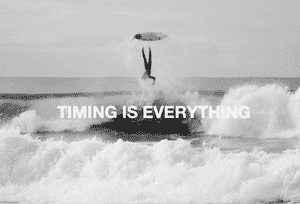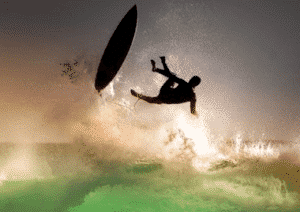The term wipe out connotes an air of failure. At many a surf competition you will hear the commentator yell “Wipe out!” as a surfer gets thrown from his or her board in a seemingly ungraceful manner. The collective “ooohhh” emitted from the crowd of spectators could lead one to believe that this wipe out was some sort of unfortunate mistake executed without any control or technique by the surfer who suffered the brunt of a powerful wave. However, things aren’t always as they seem. The proper wipe out takes skill and grace just like any other aspect of the sport. In fact, on closer inspection, the way surfers wipe out is almost excruciatingly beautiful.

Dings: To avoid dings in the board that may occur if the board hits you, the floor, or another surfer. Dings are fixable, but the time it take to fix them will take away from your surf time!
Broken boards: Many of the boards that break get broken because of the powerful lip of the wave, not because they hit the bottom.
Neck Injuries: If you hit the bottom of the ocean head first, you run the risk of seriously injuring your neck and/or back. This is a major reason why your positioning when you wipe out is very important.
Cuts and such: Fins are very sharp and the nose of shirtboards can puncture your skin. Broken boards can also have jagged edges and sharp exposed fiberglass.
Hitting other surfers: Surfing isn’t like bumper cars, and you are in for a rude awakening if you think you can just bounce off the other surfers unharmed.
Drowning: This is the most extreme case, and is very rare especially since most good surf instructors are trained beach lifeguards (at School of the World all of our instructors are lifeguards and CPR certified). However, the ocean is powerful and it behooves you to treat its power with respect by taking the proper precautions while surfing.
Things To Keep In Mind When Wiping Out
What is on the bottom: If you are surfing in Costa Rica, it is likely that you have smooth sand beneath you and you are free to push off the bottom. However, if you are surfing someplace like Hawaii where there can be coral reef you have to be careful to avoid those sharp edges.
Where is your board: It is imperative that you always know where your board is. If your board is between you and a wave, look out because most likely it will be caught by the wave and pushed at you.
Where other surfers are: If there are other surfers around you their boards and bodies can become a danger to you if you cross paths a little too closely. Keep your eyes open to their positions in relation to where you are.
What other obstacles there are: Take a few moments and look around to see what obstacles may be in your way; rocks, piers rip currents, etc. It is always a good idea to survey your surroundings before you enter the water.
Wiping Out Properly
1. Jump Away From Your Board: If you know your wipe out is imminent use that knowledge to steer yourself away from your board. Try to jump into the wave or over the wave, always try to avoid jumping in front of your board. If you jump in front of your board you run a high risk of your board hitting you in the head. A great way to jump is to go straight off the back of your board. One of the best spots to aim for is the white water- because it is already churning your impact is braced by the opposing forces of the water. No matter how you fall though, always keep at least one arm extended to push the board away from you.
2. Jump Shallow: Whenever you are jumping off your board always jump as if you are jumping into a shallow pool. Sometimes you will think the water is deeper than it actually is, so always jumping as though the water is shallow will help you avoid unnecessary collisions with rocky bottoms.

4. Cover your Noggin: Whatever you do, DO NOT GO HEAD FIRST! Most people do not surf with a helmet so it is important to protect your head. When you are underwater spinning around use one or both hands to protect your head.
5. Remain Calm: Sometimes it can seem as if you have been underwater for an eternity, but you would be surprised at how long you can actually hold your breath. Panicking and fighting against the wave only uses more oxygen, so your best bet is to remain loose and calm.
6. Get Low: It is calmer closer to the floor of the ocean. The waves and white water do a lot of moving around towards the surface, but the lower that you are the less movement that there is. Sometimes you can pass right under the waves by letting yourself sink down a bit.
7. Open Your Eyes: Many times the water around you is pretty clear, if you open your eyes you will see what is around you which will make things a lot easier.
8. Come Out of the Water Slowly: Your first instinct might be to pop up as quickly as possible so that you can gulp in a needed breath of air, but if your board happens to be above you, you will be looking at a colorful new bruise. So come up slowly, keeping one arm above you just in case.
9. Get Control of Your Board Quickly: As soon as you get back up get control of your board as fast as possible. You don’t want it flopping around at the end of the leash where it might hit someone. Swim over to the board or reel it in using the leash. Get on the board and get out of the way of incoming breaks and other surfers.
10. Relax and Evaluate: Once you have gotten back on your board and are safely away from other breaking waves or surfers, take a minute and catch your breath. Think about what you did well and what you can improve on. If there were any parts of your wipe out you think you can improve, have no fear, you will have plenty of other chances to practice!

Check out all the fun we’re having, right now, at the School of the World!
to reach our office directly +506.2643.2462
to reach a guest +506.2643.1064
U.S. number that connects to our office
+1-305-517-7689
schooloftheworld (skype)
Check out all the fun we’re having, right now, at the School of the World!
to reach our office directly
+506.2643.2462
to reach a guest +506.2643.1064
U.S. number that connects to our office +1-305-517-7689
schooloftheworld (skype)





